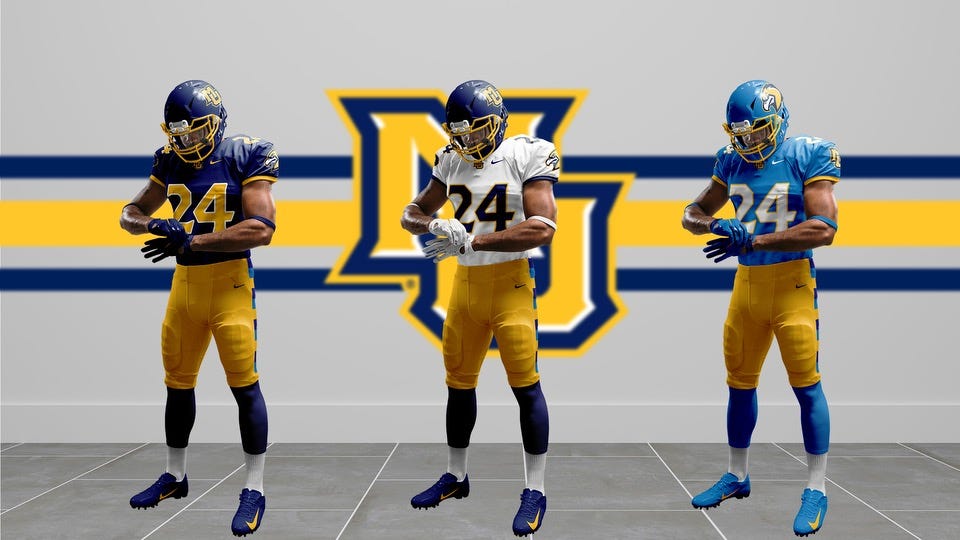Stadium Size, Football Droppers, and Deemphasizers: Marquette
This series reviews the program history and stadium sizes of colleges that dropped or deemphasized football. Click here for the series introduction. The schools included in the review are listed below.
Marquette football began in 1892. It fielded teams through all the war years before succumbing to the budget concerns caused, in their view, by televised college and pro football. Fans who once might have jumped on the trolley to see a football game opted to stay home rather than watch the local team lose another game.
Marquette football had moments in the sun, notably in the 1920s and 1930s under Frank Murray. Their 1936 team went 7-2, including a loss to TCU and Sammy Baugh in the 1936 Cotton Bowl. Marquette's Ray Buivid finished third in the Heisman voting that year, one play ahead of Sammy Baugh.
The Golden Avalance played at Marquette Stadium, built in 1924 just west of campus. The stadium seated 24,000 the day it opened and 24,000 the day it closed, while many of its high-profile competitors increased its capacity over the years.

After the Cotton Bowl appearance and 15 years at Marquette, coach Frank Murray left to take the reins at Virginia for nine years before returning to Milwaukee for another four-year run in 1946, during which he failed to rekindle the magic. Marquette had only two winning seasons (1942 and 1950) after their Cotton Bowl season until the program's demise in 1960.
By 1960, Marquette was the nation's largest Catholic university -now the 10th largest- and committed to raising $30 million for academic enhancements. Meanwhile, the football program lost $50,000 annually due to attendance woes. While they had played a competitive schedule over the last few decades, their schedule quality slipped in the latter 1950s. The big Catholic-on-Catholic games with St. Mary's or Santa Clara at Soldier Field that attracted 40,000+ crowds in the 1930s were gone, and by playing fewer top programs on the road, their share of the gate also dropped.
We can illustrate Marquette's challenge by comparing them against in-state rival Wisconsin. Playing an early season game in Madison almost every season, with Wisconsin holding a 32-4 lead in the series, the teams shared the gate 50-50. Wisconsin opened the season at Stanford before 29,500 fans and played before 48,000 at Illinois, but the Marquette game with 51,000 fans was the season's next lowest attendance. Meanwhile, Marquette's top home crowd was 17,000, and their only decent crowd at an away game besides Wisconsin came at Indiana with 27,000.

Moreover, with college teams playing only nine games in the regular season and the Big Ten discussing a shift to a round-robin football schedule—which would shut Marquette out of its biggest payday—the good fathers saw little opportunity for the program's future viability.
After starting the 1960 season at 3-1, with wins over Villanova, Pacific, and Boston College, they lost the rest to finish 3-6. Marquette shut down the program in December 1960, leaving future opponents to fill slots in their schedules and many younger team members looking for a new school.

2024 Concept Uniform
My brother, Steve, dabbles in sports team logos and uniforms. Here are his concept uniforms for Marquette’s imaginary 2024 team.
Next up: Xavier
Ranking by Stadium Size
Below are the schools reviewed to date, ranked by stadium size. The stadiums’ opening and demolition years (if applicable) are also noted.
Catholic (Brookland Stadium): 30,000 | 1924 - 1985
Denver (DU/Hilltop Stadium): 30,000 | 1925 - 1971
Marquette (Marquette Stadium): 24,000 | 1924 - 1977
Xavier (Corcoran Stadium): 15,000 | 1929 - 1988
Gonzaga (Gonzaga Stadium): 12,000 | 1922 - 1949
California State University, Fullerton (Titan Stadium): 10,000 | 1992 - TBD
Boston University (Nickerson Field): 10,000 | 1915 - TBD
Vermont (Centennial Field): 10,000 | 1923 - TBD
NYU (Ohio Field): 5,000 (est.) | 1897 - 1947
San Francisco (St. Ignatius Stadium): <5,000 (est.) | c. 1909 - c. 1930
Carnegie-Mellon (Skibo Bowl): 4,500 | 1960 - 1987 | Gesling Stadium: 3,900 | 1990 - TBD
Sewanee (McGee Field): 3,000 | 1891 - TBD
Schools to Review
California State University, Long Beach | University of California, Santa Barbara | Case Western | Chicago | CCNY | Creighton | DePaul | Detroit | Drake | Loyola (Chicago) | Nebraska-Omaha | Pacific | St. Louis | Santa Clara | Tampa | Washington University in St. Louis | Wichita State
Football Archaeology is reader-supported. Click here to buy one of my books or otherwise support the site.



Great stuff! I like the rekindling of the memories of these once proud programs